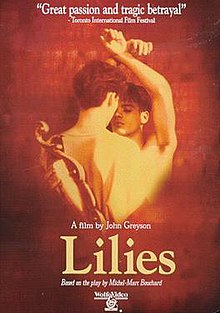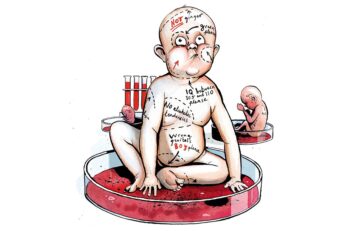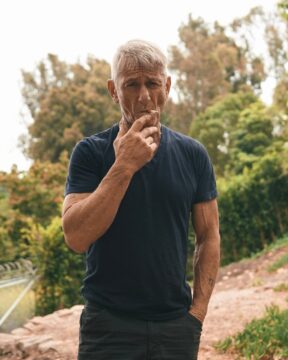Category: Archives
The Perverse Magic of Long Ago
B. Ruby Rich at The Current:
 Before he made Lilies (1996), the feature that became his grand masterpiece, John Greyson was already known for his groundbreaking work in video. Identified by his irreverent humor, dance-hall pastiches, fierce political commitment, and brash inventiveness, the Canadian artist had amassed a global following through various showcases, including in New York and at the Berlin Film Festival. I met him when he was just starting out as a young man in New York City championing video and, as he would go on to do throughout his career, the work of other artists.
Before he made Lilies (1996), the feature that became his grand masterpiece, John Greyson was already known for his groundbreaking work in video. Identified by his irreverent humor, dance-hall pastiches, fierce political commitment, and brash inventiveness, the Canadian artist had amassed a global following through various showcases, including in New York and at the Berlin Film Festival. I met him when he was just starting out as a young man in New York City championing video and, as he would go on to do throughout his career, the work of other artists.
Based on a play by Quebec playwright Michel Marc Bouchard, Lilies was Greyson’s first adaptation and his first work to be made in 35 mm. The film wraps its transgressive themes—forbidden sexuality, race, gender, the Catholic Church, murder, and the miscarriage of justice—in a voluptuous style that alternates polished tableaux of an imagined 1912 with rougher scenes staged forty years later.
more here.
Tuesday Poem
O Taste and See
The world is
not with us enough.
O taste and see
the subway Bible poster said,
meaning the Lord, meaning
if anything all that lives
to the imagination’s tongue,
grief, mercy, language,
tangerine, weather, to
breathe them, bite,
savor, chew, swallow, transform
into our flesh our
deaths, crossing the street, plum, quince,
living in the orchard and being
hungry, and plucking
the fruit.
Denise Levertov
from Literature and the Writing Process
Prentice Hall, 1996
Monday, June 24, 2024
3 Quarks Daily Welcomes Our New Monday Columnists
Hello Readers and Writers,
We received a large number of submissions of sample essays in our search for new columnists. Most of them were excellent and it was very hard deciding whom to accept and whom not to. If you did not get selected, it does not at all mean that we didn’t like what you sent; we just have a limited number of slots and also sometimes we have too many people who want to write about the same subject. Today we welcome to 3QD the following persons, in alphabetical order by last name:
- Azadeh Amirsadri
- Katalin Balog
- Gary Borjesson
- Monte Davis
- Mark DeLong
- Eric Feigenbaum
- John Hartley
- Xavier Muller
- Malcolm Murray
- Laurence Peterson
- Eleni Petrakou
- Rachel Robison-Greene
- Eric Schenck
- Daniel Shotkin
- Adele Stanislaus
- Steve Szilagyi
- Jeroen van Baar
- Sander Van de Cruys
I will be in touch with all of you in the next days to schedule a start date. The “Monday Magazine” page will be updated with short bios and photographs of the new writers on the day they start.
Thanks to all of the people who sent samples of writing to us. It was a pleasure to read them all. Congratulations to the new writers!
Best wishes,
Abbas
Sunday, June 23, 2024
Plants Warn, Defend, Scream, Remember, and Plan Ahead
Jeannette Cooperman in The Common Reader:
![]() Tempted as I am to lavish consciousness on everything around me, I was fascinated to learn that tobacco and tomato plants click when they are stressed. The frequency is too high for us to hear these distress calls, but mice and moths do. As a plant dehydrates, the clicking speeds up, as though they are nervously cracking their knuckles. The beach evening primrose reacts to the sound of bees buzzing by secreting a sweeter nectar. Deprived of water, plants avoid dehydration by tightening the pores in their leaves. Roots avoid salt in the soil by inching toward areas that are less salty. Grains of starch shift with gravity, telling a plant which way is up. Flowers plan ahead, turning toward the sun before it rises and timing their pollen production to be ready when a pollinator shows up. Plants release volatile chemicals when they are eaten or infected or mowed down (that summertime freshly-mown-grass smell we all rhapsodize about). Neighboring plants receive this communication and take, when possible, defensive measures.
Tempted as I am to lavish consciousness on everything around me, I was fascinated to learn that tobacco and tomato plants click when they are stressed. The frequency is too high for us to hear these distress calls, but mice and moths do. As a plant dehydrates, the clicking speeds up, as though they are nervously cracking their knuckles. The beach evening primrose reacts to the sound of bees buzzing by secreting a sweeter nectar. Deprived of water, plants avoid dehydration by tightening the pores in their leaves. Roots avoid salt in the soil by inching toward areas that are less salty. Grains of starch shift with gravity, telling a plant which way is up. Flowers plan ahead, turning toward the sun before it rises and timing their pollen production to be ready when a pollinator shows up. Plants release volatile chemicals when they are eaten or infected or mowed down (that summertime freshly-mown-grass smell we all rhapsodize about). Neighboring plants receive this communication and take, when possible, defensive measures.
Most astounding, plants learn.
More here.
Recycling Plastic Is a Dangerous Waste of Time
Frank Celia at Quillette:
 By now, you probably know that plastic recycling is a scam. If not, this white paper lays out the case in devastating detail. To summarise, amid calls to reduce plastic garbage in the 1970s and ’80s, the petrochemical industry put forth recycling as a red herring to create the appearance of a solution while it continued to make as much plastic as it pleased. Multiple paper trails indicate that industry leaders knew from the start that recycling could never work at scale. And indeed, it hasn’t. Only about nine percent of plastic worldwide gets recycled, and the US manages only about six percent.
By now, you probably know that plastic recycling is a scam. If not, this white paper lays out the case in devastating detail. To summarise, amid calls to reduce plastic garbage in the 1970s and ’80s, the petrochemical industry put forth recycling as a red herring to create the appearance of a solution while it continued to make as much plastic as it pleased. Multiple paper trails indicate that industry leaders knew from the start that recycling could never work at scale. And indeed, it hasn’t. Only about nine percent of plastic worldwide gets recycled, and the US manages only about six percent.
As bad as this is, the situation might actually be much worse. According to an emerging field of study, the facilities that recycle plastic have been spewing massive amounts of toxins called microplastics into local waterways, soil, and air for decades. In other words, the very industry created to solve the plastic-waste problem has only succeeded in making it worse, possibly exponentially so. While the study that kicked off this new field received some press coverage when it appeared last year, the far-ranging import of its findings has yet to be fully integrated into environmental science. If the research is even close to accurate, and to date it has not been substantively challenged, the implications for waste management policies across the globe will be game-changing.
More here.
The quiet return of eugenics
Louise Perry in The Spectator:
 Emerging technology is about to present parents with a set of ethical questions that make the usual kinds of debates – breast milk or formula? Nanny or daycare? – seem trivial. We have always had the power (more or less) to control our children’s nurture. Before long – perhaps in just a few years – any parent who can afford to will have control over the minutest details of a child’s nature too.
Emerging technology is about to present parents with a set of ethical questions that make the usual kinds of debates – breast milk or formula? Nanny or daycare? – seem trivial. We have always had the power (more or less) to control our children’s nurture. Before long – perhaps in just a few years – any parent who can afford to will have control over the minutest details of a child’s nature too.
The crucial change set to turn our lives upside-down is called ‘preimplantation genetic testing for polygenic disorders’ (PGT-P), hereafter ‘polygenic screening’. Testing a foetus or embryo for some conditions is now a routine part of the modern pregnancy experience. Prenatal Down’s Syndrome tests, for instance, are so widespread that in some Scandinavian countries almost 100 per cent of women choose to abort a foetus diagnosed with the condition, or – if using IVF – not implant the affected embryo. The result is a visible change to these populations: there are simply no more people with Down’s to be seen on the streets of Iceland and Denmark.
More here.
Columbia Law Review article critical of Israel sparks battle between student editors and their board − highlighting fragility of academic freedom
Neal H. Hutchens at The Conversation:
 Editors of Columbia Law Review, a prominent journal run by students from the prestigious university’s law school, say the publication’s board of directors urged them on June 2, 2024, to refrain from publishing an article critical of Israel.
Editors of Columbia Law Review, a prominent journal run by students from the prestigious university’s law school, say the publication’s board of directors urged them on June 2, 2024, to refrain from publishing an article critical of Israel.
After the students published the article online the following day, the board, which includes Columbia Law School faculty members and alumni, had the law review’s website taken down.
The board soon relented and allowed the website back online on June 6, including the article in question. But it issued a statement accusing the student editors of failing to properly review the article prior to publication.
The student editors have rejected the assertions in the board’s statement and say they’re “on strike” – refraining from some of their review duties – to protest the board’s attempts to stifle them.
More here.
Donald Sutherland (1935 – 2024) Actor
Willie Mays (1931 – 2024) Baseball Player
James Chance (1953 – 2024) Punk, Jazz, No Wave Musician
Sunday Poem
In Reply
Tell me, Rock, do you think
my mother misses feeling gravity’s sly tug
as she lifted her hand
to brush my cheek?
And would that be enough to lure her back
to sniff her roses,
to feel again the planet’s brow beneath her feet?
It seemed she loved it here.
But what do I know
of the dead, what they miss? I ask you questions,
Rock. And feel in reply,
the absence that grows
when the last of the afternoon birds goes quiet
and the evening birds
haven’t yet sung.
by Clare Rossini
from Plume Magazine
can you inherit memories from your ancestors?
Hannah Critchlow in The Guardian:
 Since the sequencing of the human genome in 2003, genetics has become one of the key frameworks for how we all think about ourselves. From fretting about our health to debating how schools can accommodate non-neurotypical pupils, we reach for the idea that genes deliver answers to intimate questions about people’s outcomes and identities. Recent research backs this up, showing that complex traits such as temperament, longevity, resilience to mental ill-health and even ideological leanings are all, to some extent, “hardwired”. Environment matters too for these qualities, of course. Our education and life experiences interact with genetic factors to create a fantastically complex matrix of influence. But what if the question of genetic inheritance were even more nuanced? What if the old polarised debate about the competing influences of nature and nurture was due a 21st-century upgrade?
Since the sequencing of the human genome in 2003, genetics has become one of the key frameworks for how we all think about ourselves. From fretting about our health to debating how schools can accommodate non-neurotypical pupils, we reach for the idea that genes deliver answers to intimate questions about people’s outcomes and identities. Recent research backs this up, showing that complex traits such as temperament, longevity, resilience to mental ill-health and even ideological leanings are all, to some extent, “hardwired”. Environment matters too for these qualities, of course. Our education and life experiences interact with genetic factors to create a fantastically complex matrix of influence. But what if the question of genetic inheritance were even more nuanced? What if the old polarised debate about the competing influences of nature and nurture was due a 21st-century upgrade?
Scientists working in the emerging field of epigenetics have discovered the mechanism that allows lived experience and acquired knowledge to be passed on within one generation, by altering the shape of a particular gene. This means that an individual’s life experience doesn’t die with them but endures in genetic form. The impact of the starvation your Dutch grandmother suffered during the second world war, for example, or the trauma inflicted on your grandfather when he fled his home as a refugee, might go on to shape your parents’ brains, their behaviours and eventually yours.
More here.
Sean Penn, Rebel With Many Causes
Maureen Dowd in The New York Times:
 Don’t mellow my harsh, dude.
Don’t mellow my harsh, dude.
I was coming to talk to Sean Penn, the notorious Hollywood hothead who helped launch the word “dude” into the American bloodstream when he played stoner surfer Jeff Spicoli in the 1982 classic “Fast Times at Ridgemont High.” I was nervous because the Times photographer was already inside the Spanish-style ranch house with Penn, who has a history of throwing punches at paparazzi. I hurried past Penn’s three surfboards and silver Airstream in the front yard, half expecting to see the un-pacific denizen of the Pacific Coast wrestling on the floor with the photographer. Nah. Penn, in dark T-shirt, Columbia utility pants and sneakers, was charming, trailed by his adoring dogs, a golden retriever and a German shepherd rescue puppy. When I joked that I was relieved to see him treating the photographer sweetly, he laughed. “When I did my 23andMe,” he said, “I thought I might be part Hopi because they don’t like to be photographed.”
Penn, a lifelong Malibu resident, pointed in the direction of his old grade school in the days of a more rural Malibu. He said he gets up at 5:30 a.m. and goes, barefoot, out to his wood shop. “I even forget to smoke for five hours.” As it turns out, Penn has finally mellowed.
At 63, the weathered, tattooed rebel with many causes is a certified humanitarian — riding the crest into dangerous crises around the globe and saving lives in New Orleans and Haiti after disasters — and a crusading documentarian. He started out making the documentary “Superpower,” thinking it would be a story of how Volodymyr Zelensky, a comedian, ascended to Ukraine’s presidency. But then Vladimir Putin pounced.
More here.
Saturday, June 22, 2024
Gaza’s Past is Calling
Sarah Aziza in Lux:
My uncle’s voice reaches me across time and space in the form of fragmentary voice notes. His words are gruff but precise as he recalls the dimensions of the two-room shelter my grandmother constructed with the barest materials on a patch of ground in Deir al-Balah, Gaza, where she arrived as a refugee and a mother of four in 1955. This was seven years after Zionist soldiers ethnically cleansed the 626 inhabitants of her village, ‘Ibdis, along with 750,000 others across Palestine in the war we call the Nakba, or “Catastrophe.”
In the years in between the erasure of ‘Ibdis and their arrival to Deir al-Balah, my grandparents, Musa and Horea, hovered a few miles from their stolen land, subsisting as sharecroppers and sheltering with not-yet-displaced Bedouins. While much of their kin scattered across Gaza, Jordan, and beyond, they strove to stay as near to their village as they could. This, despite their poverty and the “mopping up” missions of the Israeli army, which sought to expel the Palestinians who remained. They were not ready, not able to believe their exile would be final. Their loss was a reality wider than their imaginations could yet hold.
It was not until their fourth child was born — their only daughter, Bahiya — that the young parents admitted their meager wages and borrowed floors could not suffice.
More here.
Confessions of a Black Conservative
How the Philosopher Charles Taylor Would Heal the Ills of Modernity
Adam Gopnik in The New Yorker:
Lyric poets and mathematicians, by general agreement, do their best work young, while composers and conductors are evergreen, doing their best work, or more work of the same kind, as they age. Philosophers seem to be a more mixed bag: some shine early and some, like Wittgenstein, have distinct chapters of youth and middle age; Bertrand Russell went on tirelessly until he was almost a hundred. Yet surely few will surpass the record of the Canadian philosopher Charles Taylor, who is back, at ninety-two, with what may be the most ambitious work ever written by a major thinker at such an advanced age. The new book, “Cosmic Connections: Poetry in the Age of Disenchantment” (Belknap), though ostensibly a study of Romantic poetry and music, is about nothing less than modern life and its discontents, and how we might transcend them.
A hard thinker to pigeonhole, Taylor has long been a mainstay of Canada’s social-democratic left; he helped found the New Democratic Party, running for office several times in Quebec, though losing, inevitably, to the Liberal Party and the charismatic Pierre Trudeau. He’s also a Catholic and a singularly eloquent critic of individualism and secularism, those two pillars of modern liberalism. He worries about the modern conception of the self—what he has called “the punctual self”—which he takes to be rooted in Enlightenment thought, and about the primacy it accords to autonomy, reason, and individual rights. By wresting our identities away from a sense of community and common purpose, the new “atomist-instrumental” model was, he thinks, bound to produce our familiar modern alienation. We became estranged from a sense of belonging and meaning.
More here.
Inequality Without Class
Simon Torracinta in Dissent:
An academic journal article on the technicalities of tax data is not usually cause for much excitement. Yet at the end of last year, one such publication in the Journal of Political Economy set #EconTwitter afire with debate, and prompted a full column in the Economist. The paper, by Gerald Auten and David Splinter, took aim at the famous studies on rising inequality conducted by Thomas Piketty, Emmanuel Saez, and Gabriel Zucman. If one employs different assumptions, Auten and Splinter argued, post-tax income inequality in the United States appears not to have risen much since the 1960s. While Piketty and his collaborators systematically challenged the findings, their detractors were quick to the draw. “The Piketty and Saez work is careless and politically motivated,” sniped James Heckman, a Nobel-winning Chicago School econometrician.
Whether it has risen in recent decades or merely plateaued, income and wealth inequality in the United States remains staggering. But the recent controversy illustrates the high stakes of empirical research on the subject, which burst into public view in 2014 with the publication of Piketty’s Capital in the Twenty-First Century. While it is hard to imagine the Biden administration’s announcement of a “new Washington consensus” centered on the “challenge of inequality” and its push for a global minimum tax without the shock wave of the 2016 election, Piketty’s high-profile work supplied a ready explanation for what had gone wrong.
The economist Branko Milanovic made his own major contribution to the study of inequality in 2016 with his breakout Global Inequality.
More here.
Baby Reindeer: The True Story Behind Netflix’s Breakout Hit
Amy Mackelden in Bazar:
 Netflix’s Baby Reindeer became an instant hit with viewers after it debuted earlier in April, with Variety calling the seven-episode limited series “shocking, hilarious, painful, and devastating,” and The New York Times dubbing it a “mesmerizing, complex drama.” The series follows Donny (played by creator Richard Gadd), a struggling comedian and bartender whose life is thrown into disarray when a customer named Martha (Jessica Gunning) comes into the bar. Soon she is sending him hundreds of emails, before her unwanted contact escalates even further. While attempting and failing to stop his stalker, Donny is also reminded of a period in his life during which he was violently abused by a mentor, Darrien (Tom Goodman-Hill).
Netflix’s Baby Reindeer became an instant hit with viewers after it debuted earlier in April, with Variety calling the seven-episode limited series “shocking, hilarious, painful, and devastating,” and The New York Times dubbing it a “mesmerizing, complex drama.” The series follows Donny (played by creator Richard Gadd), a struggling comedian and bartender whose life is thrown into disarray when a customer named Martha (Jessica Gunning) comes into the bar. Soon she is sending him hundreds of emails, before her unwanted contact escalates even further. While attempting and failing to stop his stalker, Donny is also reminded of a period in his life during which he was violently abused by a mentor, Darrien (Tom Goodman-Hill).
While Baby Reindeer draws on events that occurred in Gadd’s real life, the series is also a work of fiction. Here’s what you need to know about the true story behind the Netflix hit.
Scottish performer Richard Gadd is as the writer, creator, and star of Baby Reindeer, and the Netflix series is the culmination of almost a decade of work. While the show takes its title from his one-man play of the same name, which debuted as part of the Edinburgh Fringe Festival in 2019, his previous work also inspired the series. In 2016, Gadd took home the Edinburgh Comedy Award for his show Monkey See Monkey Do, in which he revealed the catastrophic sexual violence he experienced as a young comic at the hands of a mentor.
More here.
The Surprising Issue That Could Help Biden With Young Voters
Daniel Cox in Time Magazine:
Joe Biden’s latest action on immigration has a whiff of desperation. It’s no secret that Biden is struggling with some core Democratic constituencies, and in taking executive action to restrict asylum seekers, the Biden campaign may be targeting wayward Republicans, centrists, and older voters, who tend to prioritize immigration. It’s not clear how effective these efforts will be, but addressing the immigration issue may help with another group of voters the campaign is struggling to reach: young voters.
Even if you are not convinced by polls showing the race effectively tied between Biden and Trump, there’s little doubt that Biden is worse off today than he was in 2020. In a new survey we conducted at the Survey Center on American Life, that includes a robust sample of more than 600 young voters, we’ve found that Biden has only a modest lead among young voters, well below his 2020 vote share.
The Biden-Harris campaign has sought to shore up support among young voters by emphasizing climate change, student loan forgiveness, and abortion rights. But what if the campaign took on the issue of immigration more directly in an effort to appeal to young voters?
It’s not as crazy as it sounds.
More here.
